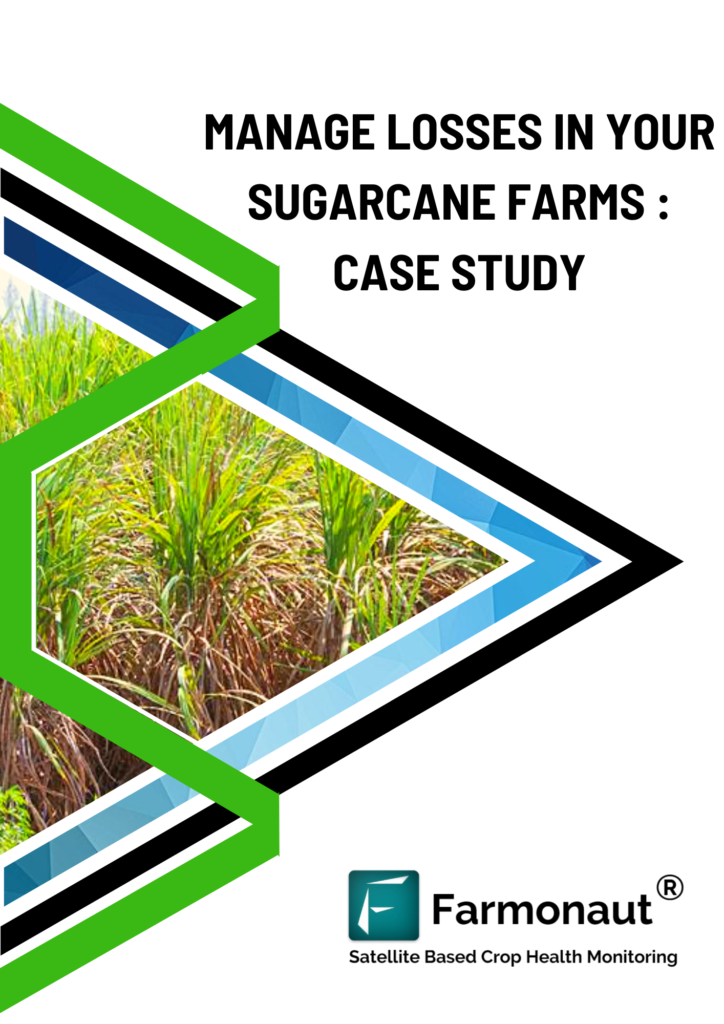Clavibacter michiganensis: 7 Ways to Control Disease
- Introduction
- Taxonomy and Classification of Clavibacter michiganensis
- Pathogenicity and Disease Mechanisms
- Symptoms of Bacterial Canker and Ring Rot
- Transmission and Survival Strategies
- Impact on Agriculture and Forestry
- 7 Proven Ways to Control Clavibacter michiganensis Disease
- Comparison Table of Management Strategies
- Modern Technologies for Plant Pathogen Management
- Farmonaut: Technology for Precision Disease Control
- Research and Future Directions
- Frequently Asked Questions
- Conclusion
Introduction: Why Control Clavibacter michiganensis?
Clavibacter michiganensis is a plant pathogen of critical concern for the global agricultural community. Its capacity to cause bacterial wilt in tomatoes and ring rot in potatoes presents a direct threat to crop yields, economic viability, and food security for countless farmers and agribusinesses. Disease outbreaks, if not managed, can result in losses exceeding 50% in susceptible crops, highlighting the importance of integrated management strategies.
In this comprehensive guide, we will explore Clavibacter michiganensis, focusing on its taxonomic classification, pathogenicity mechanisms, survival tactics, and its management through seven proven strategies. We’ll also cover the role of precision agriculture technology, such as that provided by Farmonaut, in controlling seed-borne plant diseases effectively in today’s dynamic agricultural landscape.
Focus keyword: Clavibacter michiganensis. This term appears throughout to ensure focus, SEO optimization, and clarity for readers searching for practical solutions.
Taxonomy and Classification of Clavibacter michiganensis
Understanding the taxonomy and classification of Clavibacter michiganensis is fundamental to grasping its pathogenic role in agriculture. It is the sole species within the genus Clavibacter, classified as a Gram-positive, non-sporulating, aerobic bacterium. Historically, only C. michiganensis was retained in this genus, while others were reclassified into Leifsonia, Rathayibacter, or Curtobacterium, based on molecular structure, absence of a type three secretion system, and distinguishing cell wall characteristics.
This unique bacterium lacks the type III secretion system found in many other plant pathogenic bacteria, making its mechanisms of pathogenicity distinctive and more challenging to combat.
Pathogenicity and Disease Mechanisms: How Clavibacter michiganensis Infects Plants
Clavibacter michiganensis is primarily notorious for its ability to invade and proliferate within the vascular system of host plants. The infection process typically follows this sequence:
- Entry through natural openings or wounds: The bacteria enter through cracks, pruning wounds, or points of damage on the plant, especially in tomatoes and potatoes.
- Colonization of xylem vessels: Once inside, the bacterium quickly migrates to the xylem, exploiting the plant’s transport system to disperse systemically.
- Multiplication and vascular occlusion: Enzymes such as serine proteases, cellulases, xylanases, and pectinases break down plant cell walls, leading to systemic infection, wilting, and nutrient disruption.
- Formation of biofilm-like structures: Biofilms enhance bacterial survival and movement within the plant system, making physical removal or chemical eradication more difficult.
These mechanisms facilitate spread, persistence, and the resulting characteristic symptoms of bacterial wilt and canker in tomatoes and ring rot in potatoes.
Symptoms of Bacterial Canker and Ring Rot: Identifying Clavibacter michiganensis Infection
Recognizing early symptoms is essential for preventing widespread infections. Typical symptoms for key crops are:
Tomatoes: Symptoms of Bacterial Wilt & Canker
- Wilting of leaves and shoots, progressing from lower to upper parts of the plant.
- Stem cankers, often with brown discoloration and longitudinal cracking.
- Vascular discoloration, observable when stems are cut crosswise—a distinctive brown or yellowing inside the xylem vessels.
- Fruits exhibit “bird’s-eye” lesions: small tan spots with white halos.
Potatoes: Ring Rot from C. michiganensis subsp. sepedonicus
- Broken, wilted leaves during the growing season.
- Internal ring of decay inside potato tubers, visible as a creamy yellow necrosis forming a ring below the skin.
- Soft rot and shriveling of affected potatoes, producing unmarketable produce.
Early molecular detection of plant pathogens can be performed via PCR-based tests, facilitating targeted and timely disease management.
Transmission and Survival: How Clavibacter michiganensis Persists and Spreads
A central challenge in the management of plant pathogens is the persistence of C. michiganensis through several robust survival tactics:
- Seed-Borne Pathogen: C. michiganensis is primarily seed-borne. Even a single infected seed can cause an epidemic, with the bacterium surviving in or on seeds for up to 8 months.
- Plant Debris Survival: The pathogen persists in crop debris (roots, stems, leaves), remaining viable in greenhouse conditions for 45–75 days.
- Entry Points: The bacterium invades through wounds or natural openings on the host plant, often facilitated by mechanical damage or insect feeding.
- Spread by Water, Tools, and Hands: Poor sanitation can exacerbate the transmission of the bacteria across fields.
These traits reinforce the need for farm-wide biosecurity and strategic disease control methods.
Economic Impact of Clavibacter michiganensis on Global Agriculture and Forestry
The agricultural sectors most affected by Clavibacter michiganensis are those engaged in tomato and potato cultivation. The economic losses arise from:
- Reduced yields from plant mortality and impaired fruit quality in tomatoes.
- Ring rot in potatoes—leads to unmarketable tubers from extensive internal decay.
- Increased costs for chemical treatments, biological control agents, and disease monitoring.
- Loss of competitive market position due to disease outbreaks.
Thus, robust management strategies are crucial for both large-scale agribusinesses and smallholder farms to reduce losses while maintaining productivity and sustainability.
7 Proven Ways to Control Clavibacter michiganensis Disease
Controlling Clavibacter michiganensis requires a comprehensive approach, combining both traditional practices and cutting-edge technology. Here, we present seven science-backed management and control strategies for bacterial wilt in tomatoes and ring rot in potatoes:
-
Cultural Practices and Biosecurity
- Use only certified disease-free seeds and planting material to avoid introducing the pathogen into fresh fields.
- Rigorously clean and sanitize tools, containers, and hands between field operations, minimizing the risk of spread.
- Promptly remove and destroy plant debris and crop residues after harvest to reduce sources of infection.
- Apply crop rotation for disease control, using non-host species to break the disease cycle. For example, avoid solanaceous crops (e.g., another tomato or potato planting) for at least 2–3 seasons between primary host crops.
-
Seed Treatment and Sanitation
- Utilize acid extraction and chemical seed treatments proven to kill bacteria on and within seed coats (e.g., hot water treatment, chlorine, or trisodium phosphate), thereby reducing initial infection rates.
- Employ molecular detection of plant pathogens in seed lots using PCR or ELISA for early identification of infected batches.
- Product Traceability Solution: Farmonaut’s Blockchain Traceability tools can help ensure your supply chain is transparent, with seed origins fully documented, reducing the risk of introducing contaminated seeds.
-
Chemical Controls
- Apply copper-based bactericides and selected disinfectants during the production cycle to reduce bacterial populations on crop surfaces and planting material.
- Remember, chemical effectiveness can vary, and prolonged usage may facilitate the development of resistance among pathogenic strains.
- Employ as part of an integrated program, not as a stand-alone solution.
-
Biological Control of Plant Diseases
- Integrate plant growth-promoting rhizobacteria (PGPR) such as Bacillus and Pseudomonas spp., which can suppress C. michiganensis in the rhizosphere and promote stronger plant defenses.
- Explore the use of specific bacteriophages (viruses that infect bacteria) that target Clavibacter without harming beneficial microbes.
- Biologicals can be especially effective under greenhouse and high-density production systems.
-
Resistant Varieties and Genetic Approaches
- Support and adopt resistant plant varieties as they become available through ongoing research and breeding programs.
- Implement PCR-based tests for molecular detection of plant pathogens and to screen for resistant host genotypes.
- Participate in or leverage genetic monitoring programs to stay ahead of pathogen evolution.
-
Field Monitoring and Early Detection
- Carry out regular scouting for early symptoms in high-risk fields, focusing on vascular discoloration and canker formation.
- Lead with precision: Use Farmonaut’s Satellite-Based Crop Health Monitoring tools for early indication and mapping of stress areas, potentially scaling up large-scale farm management and rapid response efforts.
-
Sanitation of Water, Soil, and Equipment
- Sterilize irrigation water if contaminated, as water is a known transmission route.
- Prevent cross-contamination between different fields or greenhouse beds with proper sanitation protocols.
- Remove soil adhering to boots and tires before moving between fields, and periodically disinfect equipment.
- Use technologies such as Farmonaut’s Fleet and Resource Management to optimize equipment allocation and reduce biosecurity risks.
Comparison Table of Management Strategies for Clavibacter michiganensis
| Management Strategy | Effectiveness (Estimated % Reduction in Disease) |
Applicability (Tomato/Potato) |
Implementation Difficulty | Estimated Cost ($/hectare) |
|---|---|---|---|---|
| Cultural Practices & Biosecurity | 50–70% | Both | Medium | $50–$150 |
| Seed Treatment & Sanitation | 60–90% | Both | Low–Medium | $30–$120 |
| Chemical Controls | 30–60% | Both | Low | $80–$250 |
| Biological Control Agents | 40–70% | Both | Medium | $60–$200 |
| Resistant Varieties | Up to 90% | Both (when available) |
Low | $50–$150 |
| Field Monitoring & Early Detection | Variable (depends on response speed) |
Both | Medium | $25–$70 |
| Sanitation of Water, Soil, Equipment | 40–70% | Both | Medium–High | $40–$110 |
Modern Technologies for Plant Pathogen Management
The future of managing seed-borne plant diseases like those caused by C. michiganensis lies in bridging proven agronomic strategies with new technologies:
- Remote Sensing and Satellite Monitoring: Provides real-time insight into crop stress, identifying potential outbreaks before widespread symptoms appear. This is especially beneficial in large cultivation areas and commercial agribusiness.
- AI-Based Farm Advisory: Artificial intelligence can interpret diverse agronomic data (weather, soil, crop stress) to deliver customized recommendations for disease prevention and resource optimization.
- Blockchain for Traceability: Ensures that every step in the seed and produce supply chain is documented, which is crucial for certifying disease-free planting material and food safety.
- API Data Integration: Allows agricultural businesses and researchers to directly incorporate satellite, weather, and farm data into their workflow, supporting robust disease management programs. For more info, explore Farmonaut’s API and Developer Docs.
Farmonaut: Precision Agriculture Tools for Disease Management
At Farmonaut, our mission is to empower the agricultural world—including individual farmers, co-operatives, government agencies, and corporate clients—by democratizing access to precision farming technologies. Our satellite-based solutions provide cost-effective, actionable insights for proactive crop health management and early detection of plant stress, including symptoms caused by plant pathogenic bacteria such as Clavibacter michiganensis.
- Satellite-Based Monitoring: Access NDVI, moisture indices, and targeted stress maps to spot early outbreaks of bacterial wilt or ring rot. Our platform is available via web, Android, and iOS apps and API integration—get started here.
- AI-Powered Advisory: The Jeevn AI system assesses real-time data, offers personalized advice, and guides strategic decision making—critical in seasons with high disease pressure.
- Blockchain Traceability: Combat seed-borne pathogens—trace the source of every seed, protect your field, and quickly isolate contamination events via Farmonaut’s Product Traceability solution.
- Fleet and Resource Management: Reduce operational biosecurity risks—optimize usage of agricultural vehicles and equipment with Farmonaut Fleet Management tools.
- Carbon Footprinting: Monitor and reduce the environmental impact of disease management efforts (e.g., excessive chemical applications) with Farmonaut’s Carbon Footprinting service.
- Access to Crop Loan & Insurance: Facilitate satellite-based field verification for hassle-free crop loans and insurance—learn more here.
Our solutions are designed to be scalable and accessible—from smallholder farmers in rural communities to nationwide agribusinesses—ensuring no one is left behind in the fight against plant pathogens.
Research and Future Directions: Next Generation Disease Management
Continuing research into Clavibacter michiganensis is opening promising avenues for improved detection, control, and even prevention:
- Molecular studies are revealing new virulence factors (e.g., enzymes, toxins) in Clavibacter subspecies, leading to more precise targets for chemical or genetic intervention.
- Genetic diversity mapping aids in tracking pathogen evolution across geographies and supports the rapid development of resistant crop varieties.
- Advanced diagnostics: Ongoing improvements in molecular detection of plant pathogens (qPCR, isothermal amplification, lateral flow devices) now make field-side diagnosis feasible for farmers and extension workers, not just laboratories.
- Integrated digital advisory systems: Like Jeevn AI from Farmonaut, these connect remote sensing, weather data, and field scouting, guiding optimal fungicide or biological application timing and improving yield despite disease risk.
- New biological agents: Ongoing research into bacteriophages and beneficial microbes could soon offer targeted, organic-friendly solutions.
Overall, the effective management of Clavibacter michiganensis and other plant pathogenic bacteria will depend on collaborative efforts among researchers, agritechnologists, and growers, underpinned by accessible, smart technology solutions.
Frequently Asked Questions: Clavibacter michiganensis & Disease Control
-
What is Clavibacter michiganensis?
It is a Gram-positive, aerobic, non-sporulating bacterium, the sole species in the genus Clavibacter, causing bacterial wilt in tomatoes and ring rot in potatoes. -
How is Clavibacter michiganensis detected?
Early detection is achieved using molecular tools such as PCR. Farmonaut’s digital platform also helps by pinpointing stress areas via satellite imagery for targeted laboratory testing. -
How does bacterial wilt in tomatoes differ from ring rot in potatoes?
Bacterial wilt causes wilting, vascular discoloration, and cankers in tomatoes. Ring rot creates a creamy necrotic ring in potato tubers, leading to decay and shriveling. -
Why is seed treatment important?
Because infections are primarily seed-borne, proper seed treatment greatly reduces disease incidence and supports healthy plant establishment. -
What are the latest innovations for managing seed-borne plant diseases?
Integration of satellite-based field monitoring, blockchain traceability, AI-powered crop advisory, and new biologicals such as bacteriophages. -
How can I use Farmonaut to help manage Clavibacter infections?
Farmonaut enables real-time field monitoring, early stress detection, actionable crop advisories, and efficient farm resource management. Visit Farmonaut to get started. -
Is crop rotation effective for disease control?
Yes, crop rotation for disease control is one of the most effective strategies for breaking the infection cycle of many soil- and seed-borne pathogens, including Clavibacter.
Conclusion: A Roadmap for Effective Disease Management
Clavibacter michiganensis remains a formidable threat in the global cultivation of tomatoes and potatoes, affecting both small- and large-scale agricultural sectors. By integrating the seven proven strategies—from rigorous seed management and sanitation to the adoption of digital monitoring tools and biologically based controls—growers can dramatically reduce losses and safeguard their crops.
Solutions like those from Farmonaut make once-exclusive precision agriculture tools affordable and accessible, empowering everyone in the value chain—from the field to the finish line of the supply chain. Whether you operate a local farm or manage vast agribusiness interests, implementing these evidence-based practices—guided by real-time data and advanced analytics—is the key to overcoming the challenges posed by plant pathogenic bacteria.
For more advanced support or to start making data-driven decisions today, try Farmonaut’s digital farm management platform via web, Android, or iOS, and discover how technology is revolutionizing plant health worldwide.


















